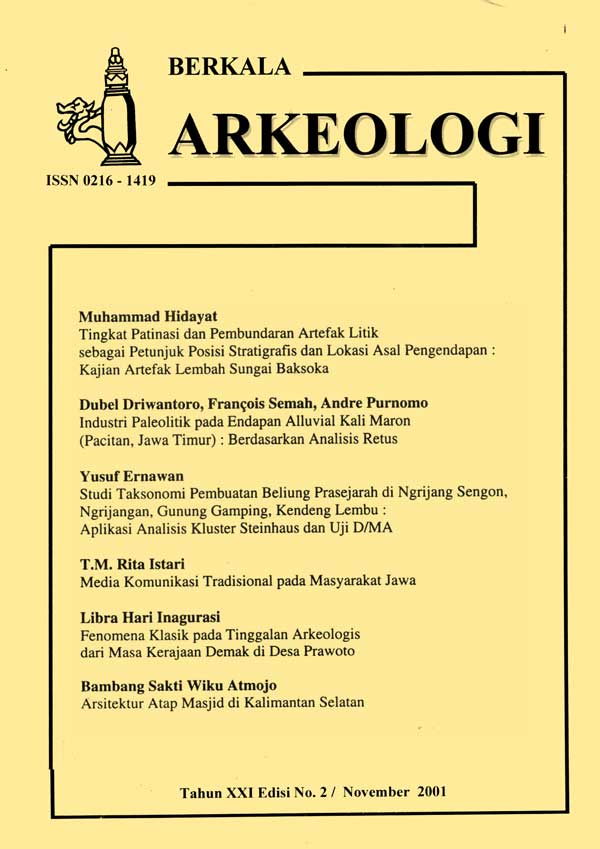INDUSTRI PALEOLITIK PADA ENDAPAN ALLUVIAL KALI MARON (PACITAN, JAWA TIMUR) BERDASARKAN ANALISIS RETUS
Main Article Content
Abstract
Kali Maron is an archaeological site whose artifatcs are no longer insitu, because sedimentological analysis has proven that its lithic artifacts are the result of river sediment. The location of the Maron River which is very close to the sea (downstream), does not allow a clear geomorphology of the terraces: lithic artifacts are found on the river bed. However, the large amount of artifact content in the sediment (7, 7% of the total composition) makes the Maron river a very rich site. The existence of these artifacts that have never been disturbed makes the Maron industry quite representative from a statistical point of view. The alluvial matrix of the artefacts previously described (disctance of transportation before deposition) also means significant proportions, where the Maron river site fully reflects the exploitation of lithic artifacts in the surrounding area.
Article Details

This work is licensed under a Creative Commons Attribution-NonCommercial-ShareAlike 4.0 International License.
References
Barstra, GJ, 1976. Contribution to the Study of the Paleolithic Patjitan Culture, Java, Indonesia. Leiden, EJ Brill ed.
Barstra, GJ, 1983. Some remarks upon : Fossil Man from Java, His Age and His Tools. Koninklijk lnstituut Voor Tall-, Land-, en Volkenkunde. 139, pp. 421--434.
Driwantoro, Dubel, 1999. Laporan Hasil Penelitian Situs Song Terus, Tahap V. Unpublished report, Pusat Penelitian Arkeologi dan MNHN, Jakarta.
Heekeren, HR van., 1955. New Investigations on The Lower Paleolithic Patjitan Culture in Java. Berita Dinas Purbakala, Jakarta, 1, hlm. 1--28.
Heekeren, HR van., 1972. The Stone Age of Indonesia. Martinus Nijhoff ed., Den Haag.
Koenigswald, GHR von, 1936. Early Paleolithic Stone Implements from Java. Bull Raffles Museum Singapore, 1, pp. 52--60.
Movius, HL, Jr. 1944. Early Man and Pleistocene Stratigraphy in Southern and Eastern Asia. Papers of the Peabody Museum of American Archaeology and Ethnology, Harvard Univ., XIX, No. 3.
Riviere, A. , 1977. Methodes Granulometriques : Techniques et Interpretation. Mason ed., Paris
Sartono, S., 1964. Stratigraphy and Sedimentation of Easternmost Part of Gunung Sewu (East Jawa). Direktorat Geologi Bandung, Publikasi Teknik Seri Geologi Umum, No. 1.
Semah, F., A-M Semah, Truman Simanjuntak, 2000. Recent Advances About the Central and Eastern Java Archaeological Record. A Contribution to the Insular Southeast Asia Prehistory. in J. Mercader ed. Under the Canopy, Washington University Press, in print.
Semah, F., A-M Semah, C. Falgueres, F. Detroit, X Gallet, S. Rameau, A. Moigne, T.
Simanjuntak., 2001. The Significance of the Punung Karstic Area (Eastern Java) for the Chronology of the Javanese Paleolithic, with Special Reference to The Song Terus Cave. Modern Quaternary Research in S-E Asia, 18, Rotterdam, in print.
Simanjuntak, Truman, 1995. Cave Habitation During the Holocen Period in Gunung Sewu. Aspek-aspek Arkeologi Indonesia, No. 18, Jakarta.
Soejono, RP., 1982. New Data on the Paleolithic in Indonesia. Premier Congres International de Paleontologie Humaine, Nice, Collogue International du CNRS. l'Homo erectus et la Place de l'Homo de Tautavel Parmi les Hominides Fossiles, vol 2., pp 578--592.
Tanudirdjo, DA, 1991. Some Behavioral Aspects of the Bomoteleng Stone Adzes Workshop Site in East Java. Thesis Master, Australian National University, Canberra.

